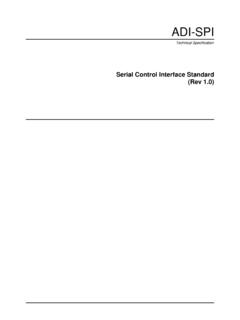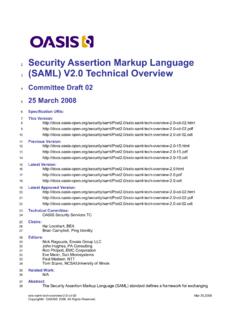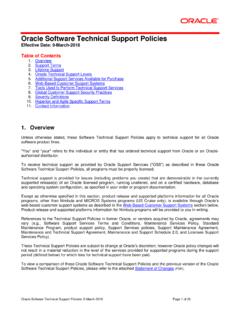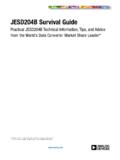Transcription of TECHNICAL NOTE Overview of IRIG-B Time Code Standard
1 SummaryThe IRIG-B time protocol is widely used by electric utilities, industrials, and others to ensure precise time synchronization of power system devices, such as breakers, relays and document describes the protocol, gives examples of Cyber Sciences products that support IRIG-B , and describes how this legacy protocol is being replaced by PTP (Precision Time Protocol per IEEE 1588) in modern power system applications. Overview of IRIG-B Time Code StandardIntroductionThe IRIG time codes were originally developed by the Inter-Range Instrumentation Group (IRIG), part of the Range Commanders Council (RCC) of the US Army. The stan-dard was first published in 1960 and has been revised several times by the Telecom-munications and Timing Group (TTG) of the RCC. The latest version is IRIG Standard 200-04, IRIG Serial Time Code Formats, updated in September, FormatsAlthough the IRIG-B time code is best known, the Standard actually defines a family of rate-scaled serial time codes.
2 The six code formats use different pulse rates, or bit rates, as shown in the table below. IRIG Time Code FormatsFormatPulse Rate (or Bit Rate)Index Count IntervalIRIG-A1000 PPS (pulse per second)1 msIRIG-B100 PPS10 msIRIG-D1 PPM1 minuteIRIG-E10 PPS100 msIRIG-G10000 msIRIG-H1 PPS1 secondTime Code AttributesAll IRIG time code formats use pulse-width coding. A binary 1 pulse has a duration of 50% of the index count interval, and a binary 0 pulse has a duration of 20% of the index count interval. In addition Position Identifiers have a duration of 80% and are used as reference time code signals may be: Unmodulated (DC level shift, no carrier signal) Modulated (amplitude-modulated, sine wave carrier). Modified Manchester (amplitude-modulated, square wave carrier).Three types of coded expressions are used in the IRIG Standard : Binary Coded Decimal time-of-year (BCDTOY) and year (BCDYEAR) Control Functions (CF), set of bits reserved for user applications Straight Binary Seconds (SBS) time-of-day (0 to 86400 seconds) TECHNICAL NOTETN-102 IRIG Standard 200-04 IRIG Standard 200-04 TELECOMMUNICATIONS A ND T IMING GROUP IRIG SERIAL TIME CODE FORMATS DISTRIBUTION A.
3 APPROVED FOR PUBLIC RELEASE DISTRIBUTION IS UNLIMITED WHITE SANDS MISSILE RANGE REAGAN TEST SITE YUMA PROVING GROUND DUGWAY PROVING GROUND ABERDEEN TEST CENTER NATIONAL TRAINING CENTER ELECTRONIC PROVING GROUND NAVAL AIR WARFARE CENTER WEAPONS DIVISION NAVAL AIR WARFARE CENTER AIRCRAFT DIVISION NAVAL UNDERSEA WARFARE CENTER DIVISION, NEWPORT PACIFIC MISSILE RANGE FACILITY NAVAL UNDERSEA WARFARE CENTER DIVISION, KEYPORT NAVAL STRIKE AND AIR WARFARE CENTER 30TH SPACE WING 45TH SPACE WING AIR FORCE FLIGHT TEST CENTER AIR ARMAMENT CENTER AIR WARFARE CENTER ARNOLD ENGINEERING DEVELOPMENT CENTER BARRY M. GOLDWATER RANGE UTAH TEST AND TRAINING RANGE NATIONAL NUCLEAR SECURITY ADMINISTRATION (NEVADA) Sep-2017 Precision Timing for Reliable Power. NOTE Overview of IRIG-B Time Code | Sep-2017 2011-2017 Cyber Sciences, Inc. All rights Time Code DesignationsIn addition to the letter used to designate one of the six IRIG code formats, signal identification numbers are used to further describe specific characteristics.
4 Thus, the complete IRIG time code designation consists of a letter and three digits, as shown Standard 200-04 (cont.)IRIG Signal Identification Numbers (3 Digits)1st DigitModulation0 Unmodulated, DC Level Shift (DCLS), pulse-width coded1 Amplitude modulated, sine wave carrier2 Manchester modulated2nd DigitCarrier Frequency / Resolution0No carrier (DCLS)1100 Hz / 10 ms resolution21 kHz / 1 ms resolution310 kHz / 100 microsecond resolution4100 kHz / 10 microsecond resolution3rd DigitCoded Expressions0 BCDTOY, CF, SBS1 BCDTOY, CF2 BCDTOY3 BCDTOY, SBS4 BCDT O Y, BCDYEAR, CF, SBS5 BCDT O Y, BCDYEAR, CF6 BCDT O Y, BCDYEAR7 BCDT O Y, BCDYEAR, SBSB 0 0 6 Format (A, B, D, E, G or H)ModulationCarrier Frequency / ResolutionCoded ExpressionsIRIG time codes naming conventionUnmodulated or Demodulated?An IRIG-B time signal can be modulated (over a carrier signal) or unmodulated (no carrier signal), called DC Level Shift (DCLS) in the IRIG some manufacturers literature, the term demodulated is used to describe an IRIG-B DC Level Shift (no carrier signal).
5 In most cases, it may be assumed that this term is synonymous with unmodulated (DCLS).BCD: Binary Coded DecimalCF: Control FunctionsSBS: Straight Binary SecondsTOY: Time of Year3 TECH NOTE Overview of IRIG-B Time Code | Sep-2017 2011-2017 Cyber Sciences, Inc. All rights PROTOCOL DESCRIPTION Figure 4-2. IRIG B coding comparisons: level shift, 1kHz am, and Modified Manchester. Figure 4-3. Modified Manchester coding. 4-8 IRIG-B coding comparisons: DC level shift (unmodulated), 1kHz amplitude-modulated, and Modified ManchesterIRIG-B OverviewIRIG time code B ( IRIG-B ) is widely used in the electrical power industry. IRIG-B has a pulse rate of 100 pulses-per-second with an index count of 10 milliseconds over its one-second time frame.
6 It contains time-of-year and year information in a BCD format, and (optionally) seconds-of-day in SBS. IRIG-B SignalsIRIG-B is typically distributed as a DC level shift (DCLS), pulse-width coded signal ( unmodulated IRIG-B ) or as an amplitude-modulated signal based on a sine wave carrier with a frequency of 1kHz ( modulated IRIG-B ). Modified Manchester modula-tion is also specified in the Standard but is less common. A comparison of IRIG-B coding methods is shown in the figure Reference MarkersIRIG-B uses reference markers called Position Identifiers. The presence of two con-secutive reference markers signifies the start of the time frame. The first reference marker alerts that the next rising edge will be the PPS (Pulse-per-Second) marker. ( On-Time 1 PPS shown above.) Thus, the IRIG-B signal provides the full date and time once per second, as well as a precise start-of-interval reference for precise time synchronization if needed.
7 (source: IRIG Standard 200-04)TECH NOTE Overview of IRIG-B Time Code | Sep-2017 2011-2017 Cyber Sciences, Inc. All rights PROTOCOL DESCRIPTION (cont.) IRIG-B BCD time-of-year (in days, hours, minutes, seconds) and year and straight binary seconds-of-day and control bits IRIG-B EncodingIRIG-B consists of 100 bits produced every second, 74 bits of which contain various time, date, time changes and time quality information of the time signal. Consist-ing of logic ones, zeros and position identifier bits, the time code provides a reliable method of transmitting time to synchronize power equipment devices. There are three functional groups of bits in the IRIG-B time code: Binary Coded Decimal (BCD), Control Functions (CF) and Straight Binary Seconds (SBS). The BCD group contains time information including seconds, minutes, hours and days, recycling yearly. The BCD time-of-year code (BCDTOY) reads zero (0) hours, min-utes, seconds, and fraction of seconds at 2400 each day and reads day 001 at 2400 of day 365, or day 366 in a leap year.
8 The BCD year code (BCDYEAR) counts year and cycles to the next year on January 1st of each year and will count to year 2099. The (optional) SBS time-of-day code consists of the total elapsed seconds, recycling daily. SBS reads zero (0) seconds at 2400 each day excluding leap second days when a second may be added or CF group contains year, time quality, leap year, pending leap seconds and parity. Other CF bits are reserved for user-defined purposes, depending on , position identifiers separate the various components of the IRIG-B time code.(source: IRIG Standard 200-04)5 TECH NOTE Overview of IRIG-B Time Code | Sep-2017 2011-2017 Cyber Sciences, Inc. All rights ImplementationThe IRIG 200-04 Standard does not define specific signal levels for IRIG-B . Typical techniques for transmission of unmodulated IRIG-B (DCLS) include: Point to point connection of a 5V signal over coaxial cable Multi-point distribution of a 5V signal over shielded twisted-pair cable Multi-point distribution using 24 Vdc for signal and control power Multi-point RS-485 differential signal over shielded twisted-pair cable RS-232 signal over shielded cable (point to point, short distances only) Optical fiberTypical techniques for transmission of modulated IRIG-B include: Coaxial cable, terminated in 50 ohms or higher, point-to-point Shielded twisted-pair cable, with optional termination (100 ohms)Application considerationsWhen applying IRIG-B , the number and type of devices to be synchronized, the pro-tocols supported, and the distances involved all affect system architecture; therefore, each system must be engineered individually.
9 The first step may be to confirm that all devices support the same version of IRIG-B , for example: unmodulated IRIG-B (also known as 5V DC Level Shift, or DCLS), with or without the year (IEEE 1344 extensions), etc. The IRIG-B signal is wired to a general-purpose or dedicated digital input, configured to decode IRIG-B source ( , GPS receiver/clock) may be capable of synchronizing a small number of devices in series (up to 8 or 10?) but a larger number of devices may require multiple circuits, repeaters and/or isolation means. Careful consideration is needed of clock specs, cable distances and device limitations. In some cases, it may be necessary to add appropriate termination impedance to each IRIG-B signal to eliminate signal reflections. IRIG-B WIRINGIEEE 1344 ExtensionsYear information was not specified in the IRIG Standard prior to its 2004 revision. Be-fore 2004, the IEEE adopted a Standard (IEEE 1344) which included year data as part of the IRIG-B signal.
10 This variation came to be known as IEEE 1344 extensions. IEEE 1344 extensions use bits of the Control Functions (CF) portion of the IRIG-B time code. Within this portion of the time code, these bits are designated for additional features, including: Calendar Year (now called BCDYEAR) Leap seconds, and leap seconds pending Daylight Saving Time (DST), and DST pending Local time offset Time quality Parity Position identifiersTo be able to use these extra bits of information, power system devices and other equipment receiving the time code must be able to decode them. Refer to individual product manuals to determine whether IEEE 1344 extensions are supported. Since year information is now considered part of BCD (denoted as BCDYEAR), what was formerly considered B002 and B122 (with IEEE Extensions ON) would now be denoted as B006 and B126, TYPEIEEE 1344 OFFONU nmodulated, B00xB002B006 Modulated, B12xB122B126 Note: IEEE Standard 1344 was updated and replaced by IEEE Nonetheless, the term IEEE 1344 Extensions is still Type with IEEE 1344 ExtensionsIRIG-B PROTOCOL DESCRIPTION (cont.)






